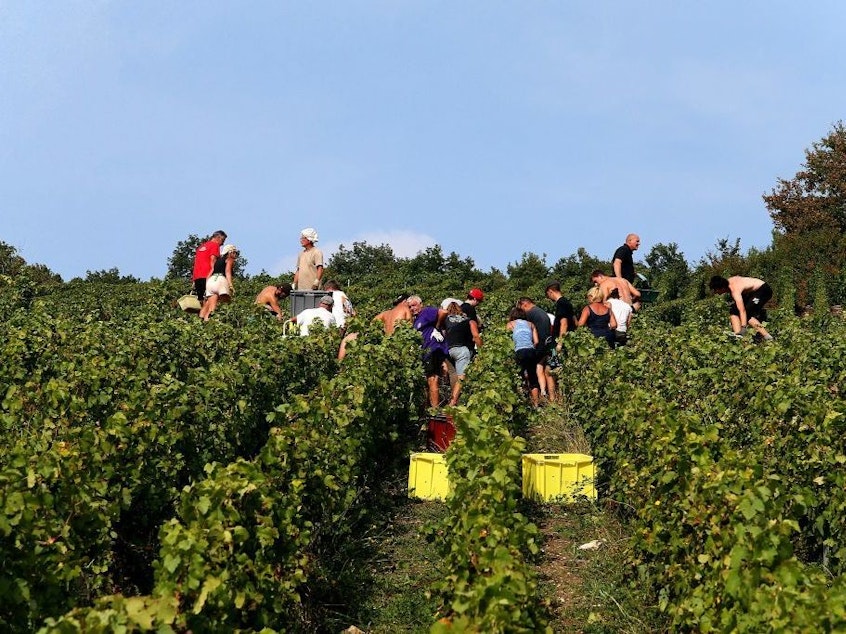Champagne Makers Bubble Over A Bumper Crop Caused By European Drought

Bells toll at the abbey where Dom Perignon is buried in the French region of Champagne. The Benedictine monk is said to have discovered the method for turning wine into champagne here more than 300 years ago.
As far as the eye can see, neat rows of vines look as if they're stitched across the rolling hillsides.
This time of year, those vines are laden with clumps of dark purple grapes — pinot noir and pinot meunier — as well as light green chardonnay grapes. The three varieties are blended to make champagne. This year, the grapes are plentiful and plump, which is not always the case in France's northernmost wine making region.
"Champagne's climate is harsh," says Vincent Chaperon, a cellar master at Dom Perignon Champagne. We have "a lot of frost – winter frost — but spring frost as well. The average temperature is quite low, there's not so much sun. And 200 days of rain [a year]. But with the evolution of climate, things have been moving in the good way, so less rain, more sun, warmer temperatures, less frost. At this moment and for about the last 15 years, the impact has been positive."
Europe had one of its hottest summers on record this year and many crops were destroyed in the heat and drought. But the summer of 2018 has produced a bumper crop in Champagne.
At harvest time the vineyards are full of grape pickers. Every grape is picked by hand, as it's been done for centuries.
"We still gather them by hand because the fruit must remain intact before they go to the press," says Vincent Malherbe, director of the vineyards at champagne maker Moet et Chandon. "Because in Champagne we make white wine with grapes with dark skin. So we can't crush them and allow the skins to taint the clear juice."
Malherbe says the three-week harvest season, or vendanges, typically begins in mid-September. But this year that's when it ended.
Claude Bucot has been harvesting grapes in Champagne for the last 27 years. He comes down from the north of France with a big group of friends and family. They laugh and joke as they pick along the rows of vines. It's hard work, he says, but also convivial and fun. Bucot shows how he pulls back the leaves and clips the dense clusters of grapes from the vine before dropping them into a basket.
"The weather determines when the three-week harvest begins, and that's been anywhere from August to October," says Bucot.
But Bucot says it's been starting earlier and earlier. "We come down a week or even two weeks before we did 20 years ago."
Chaperon, the cellar master at Dom Perignon, says since the 1990s, the vegetative cycle in Champagne is getting shorter. "The budding and the peaking are advanced," he says. "So the harvest is advancing as well." Chaperon says the harvest has begun in August only five times in the whole history of Champagne. And four of those times have been in this century. This year it began in some places on Aug. 20.
He says global warming has had some very negative effects on southern French wine making regions. "The water deficit is getting so bad that in the future winemakers may have to irrigate," he says. Irrigating vineyards in France is currently not permitted.
On the plus side, winemakers in Champagne say the warmer temperatures are increasing the quantity and quality of their grapes. But they admit that the new climate may end up changing many old winemaking methods. They say it will be important to adapt.
"What I'm hearing around me, even from people older than 80 years, is that this is the best harvest they've ever had," says Philippe Schaus, the CEO of Moet Hennessy.
Experts are predicting a sharp rise in production — perhaps up as much as 50 percent from last year. Schaus says some of the excess wine will be stored for use in leaner harvest years. But that still leaves a lot to be bottled.
The Champagne region typically produces 300 million bottles a year. 2018 will yield at least 10 million more bottles than last year, and it is expected to be some of the best bubbly in history. [Copyright 2018 NPR]



